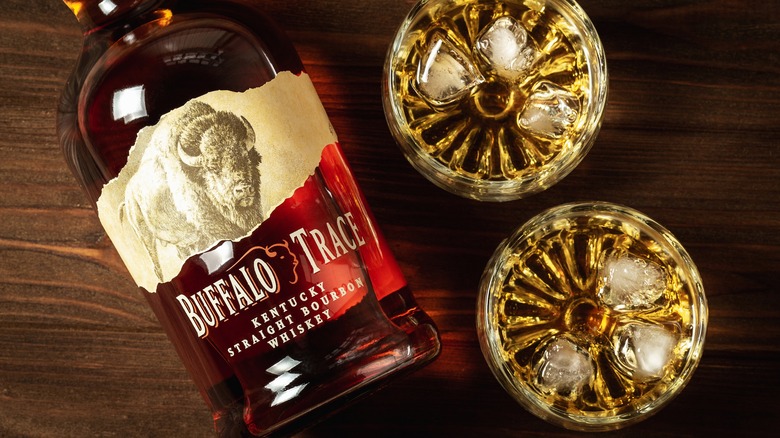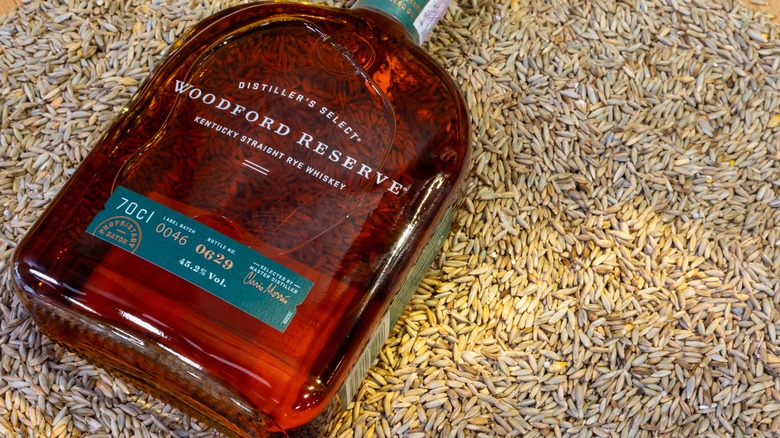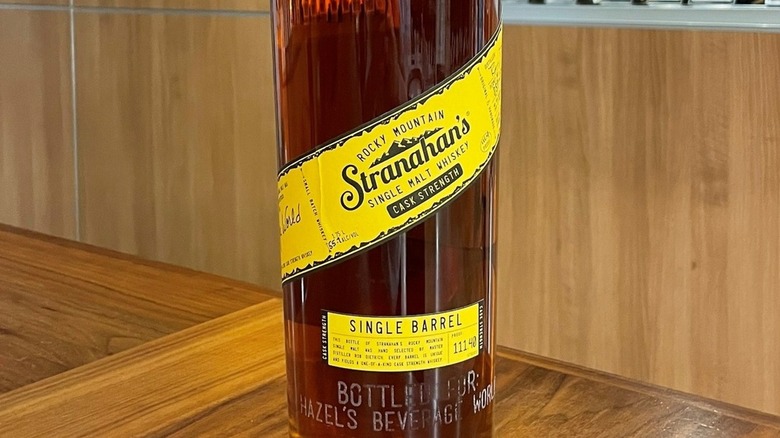How To Easily Tell Different Whiskey Types Apart
When someone offers you a glass of whiskey, you may wonder what you are getting into. Is it bourbon, Scotch, or a spicier rye? There are some things you can tell by simply looking at whiskey, but the taste isn't one of them. Without the category it fits into being announced, how can you recognize which is which by flavor?
To find out, we sought the expert advice of Chris Blatner, an Executive Bourbon Steward and creator of @urbanbourbonist on Instagram. He gave Foodie exclusive explanations regarding various flavor profiles so you can start to taste whiskey like a pro. However, because all varieties of the spirit are made slightly differently between distilleries, this isn't a hard science. When trying to discern what kind of amber liquor is before you, he says, "This can be difficult if you are doing a blind tasting but different styles of whiskey have some general qualities that may help you identify them."
Scotch, for example, can have a range of flavors based on how it is produced. Nonetheless, there are common distinctions unique to Scotch. Blatner said, "Many are peated and a strong giveaway that you are drinking a peated Scotch are smokey earthy flavors and flavors of iodine and salt." These qualities are a dead giveaway that you are imbibing a Scotch, as they are rather exclusive to this particular liquor.
Irish whiskey and American bourbon
Just as Scotch only comes from Scotland, Irish whiskey is produced solely in Ireland. Laws in Ireland dictate how this liquor must be distilled, and these restrictions contribute to its unique profile. Blatner describes the taste of Irish whiskey as "Light fruity/floral notes and some cereal grain." The spirit is one of the signature ingredients in Irish coffee, and the floral and fruity flavors also combine well with ginger and lime juice in a cocktail known as the Irish Buck.
Another spirit with constraints on where it can be produced is bourbon. Only the United States can manufacture it, but despite what some would-be whiskey connoisseurs declare, bourbon does not have to come from Kentucky. Like other whiskeys, the flavors can vary depending on the distillation process, but generally, bourbon has a sweeter characterization than its cousins. Blatner says bourbon has "Sweeter flavors of corn, caramel, vanilla, toffee, along with cinnamon and baking spice."
If pairing a food course with this nectarous liquor, you would want a dessert that complements its distinct caramel and vanilla flavors. As for mixed drinks, the Kentucky Derby's classic mint julep cocktail can only be made correctly with bourbon. The sugary simple syrup and crushed mint in the cocktail enhance the sweeter nature of the spirit and come together to create a refreshing beverage for summer afternoons.
Rye whiskey can be sharp and peppery
Unlike the above-mentioned spirits, rye whiskey can be made anywhere in the world. In the United States, however, it must be composed of at least 51% rye grain. Depending on the percentage of rye versus corn in the mash when distilled, it can sometimes taste strikingly similar to bourbon. This is why rye and bourbon are interchangeable in cocktails like Manhattans and old fashioneds with simple syrup.
Rye grain has a distinct flavor that lends spicy notes to the liquor and gives it a notably dry finish. Blatner describes the profile of rye whiskey as "Spicier bolder pepper flavors along with some citrus and oftentimes an herbal quality along the lines of dill or mint." Foods like goat cheese pair well with this liquor because the tanginess balances its spicy overtones and accents its herbal characteristics. Whether this whiskey is sipped neat or with ice, it has a powerful, pungent aroma that is easy to distinguish compared to other varieties.
American single malt whiskeys
If you're searching for a whiskey with a more delicate profile, American single malt might be right up your alley. Blatner characterizes the taste as "Malty grain, fruit and an overall lighter flavor profile." Although single malt is typically associated with Scotch, American single malt isn't simply American Scotch.
It's technically not an authorized classification of whiskey ... at least not yet. In 2022, the Alcohol and Tobacco Tax and Trade Bureau proposed setting an official standard for how American single malt is produced, making it an official category. While it has been made since the 1980s, there was no enforcement to ensure it was created according to specific standards – unlike bourbon and rye. The newly proposed rules fall in line with how most distillers of American single malt are already making it — namely, using 100% malted barley in the mashbill.
Just as bourbon takes on a sweeter profile from the corn required in the mashbill, American single malt receives a lighter, malty flavor from being composed of only malted barley. Scotch is made under the same regulation, but where the barley is grown also impacts the flavor of the whiskey. Barley harvested in Scotland tastes different from barley grown in the United States. Variations in heat and humidity during the distillation process plays into the overall flavor as well. While they have similar production standards, they can be easily distinguished from one another in terms of flavor.



